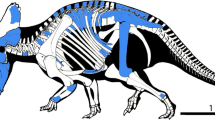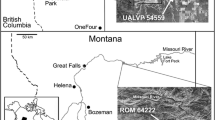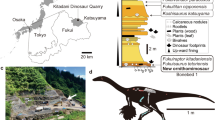Abstract
Ceratopsid dinosaurs represent one of the best known dinosaur groups in the Late Cretaceous, and their unquestionable fossil records are exclusively restricted to western North America. Here we report a new ceratopsid dinosaur, Sinoceratops zhuchengensis gen. et sp. nov., from the Upper Cretaceous Wangshi Group of Zhucheng, Shandong Province, China. Cladistic analysis places this new taxon as the only known ceratopsid from outside North America, in a basal position within the Centrosaurinae. It is considerably larger than most other centrosaurines but similar in size to basal chasmosaurines. Furthermore, it is more similar to chasmosaurines than to other centrosaurines in several features, thus blurring the distinction of the two ceratopsid subgroups. This new find not only provides significant information on the morphological transition from non-ceratopsid to ceratopsid dinosaurs, but also complicates the biogeography of the Ceratopsidae, and further demonstrates that fossil sampling has profound effects on reconstructing dinosaurian biogeography.
Similar content being viewed by others
References
Dodson P, Forster C A, Sampson S D. Ceratopsidae. In: Weishampel D B, Dodson P, Osmólska H, eds. The Dinosauria. Berkeley: University of California Press, 2004. 494–516
Dodson P. The Horned Dinosaurs. Princeton: Princeton University Press, 1998. 1–346
Nessov L A, Kaznyshkina L F, Cherepanov G O. Ceratopsian dinosaurs and crocodiles of the Mesozoic of Middle Asia. In: Bogdanova T N, Khozatsky L I, eds. Theoretical and applied Aspects of Modern Paleontology. Leningrad: Nauka, 1989. 144–154
Nessov L A. Dinosaurs of northern Eurasia: New Data About Assemblages, Ecology and Paleobiogeography. St. Petersburg: Lzdatelstvo Sankt-Peterburgskogo Universiteta, 1995. 156
You H L, Dodson P. Basal Ceratopsia. In: Weishampel D B, Dodson P, Osmólska H, eds. The Dinosauria. Berkeley: University of California Press, 2004. 478–493
Farke A, Sampson S D, Forster C A, et al. Turanoceratops tardabilis—sister taxon, but not a ceratopsid. Naturwissenschaften, 2009, 96: 869–870
Sues H-D, Averianov A O. Turanoceratops tardabilis—the first ceratopsid dinosaur from Asia. Naturwissenschaften, 2009, 96: 645–652
Sues H-D, Averianov A. Phylogenetic position of Turanoceratops (Dinosauria: Ceratopsia). Naturwissenschaften, 2009, 96: 971–872
Hu C Z, Cheng Z W, Pang Q Q, et al. Shantungosaurus Giganteus. Beijing: Geological Publishing House, 2001. 1–139
Wolfe D G, Kirkland J I. Zuniceratops christopheri n. gen. & n. sp., a ceratopsian dinosaur from the Moreno Hill Formation (Cretaceous, Turonian) of west-central New Mexico. Bull New Mexico Museum Nat Hist Sci, 1998, 14: 303–317
Makovicky P J. Ceratopsians. In: Tanke D, Carpenter K, eds. Mesozoic Terrestrial Life. Bloomington: University of Indiana Press, 2001. 243–262
Makovicky P J. Taxonomic Revision and Phylogenetic Relationships of Basal Neoceratopsia (Dinosauria: Ornithischia). New York: Columbia University, 2002. 1–297
Chinsamy A, Hillenius W J. Physiology of nonavian dinosaurs. In: Weishampel D B, dodson P, Osmólska H, eds. The Dinosauria. Berkeley: University of California Press, 2004. 643–659
Kirkland J, Blieux D. New horned dinosaurs from the wahweap Formation, Grand Staircase-Escalante National Monument, southern Utah. Utah Geologica Survey: Survey Notes 2007, 39: 4–5
You H L, Dong Z M. A new protoceratopsid (Dinosauria: Neoceratopsia) from the Late Cretacesou of inner Mongolia, China. Acta Geol Sin, 2003, 77: 299–303
Wu X C, Brinkman D B, Eberth D A, et al. A new ceratopsid dinosaur (Ornithischia) from the uppermost Horseshoe canyon Formation (upper Maastrichtian), Alberta, Canada. Can J Earth Sci, 2007, 44: 1243–1265
Ryan M J. A new basal centrosaurine ceratopsid from the Oldman Formation, southeastern Alberta. J Paleontol, 2007, 81: 376–396
Goloboff P A. NONA (ver 2.0). S. M. de Tucuman, Argentina. 1993
Nixon K C. Winclada (BETA) ver. 0.9.9. Ithaca, New York, USA. 1999
Xu L, Lü J C, Zhang X L, et al. A new nodosaurid from the Cretaceous of Ruyang, Henan (in Chinese). Acta Geol Sin, 2007, 81: 433–438
Hutchinson J R, Chiappe L M. The first known alvarezsaurid (Theropoda: Aves) from North America. J Vertebr Paleontol, 1998, 18: 447–450
Longrich N R, Currie P J. Albertonykus borealis, a new alvarezsaur (Dinosauria: Theropoda) from the Early Maastrichtian of Alberta, Canada: Implications for the systematics and ecology of the Alvarezsauridae. Cretaceous Res, 2009, 30: 239–252
Ji Q, Norell M A, Makovicky P J, et al. An early ostrich dinosaur and implications for ornithomimosaur phylogeny. Am Museum Novitates, 2003, 3420:1–19
Holtz T R. Tyrannosauridea. In: Weishampel D B, Dodson P, Osmólska H, eds. The Dinosauria. 2nd ed. Berkeley: Univeristy of California Press, 2004. 111–136
Author information
Authors and Affiliations
Corresponding author
About this article
Cite this article
Xu, X., Wang, K., Zhao, X. et al. First ceratopsid dinosaur from China and its biogeographical implications. Chin. Sci. Bull. 55, 1631–1635 (2010). https://doi.org/10.1007/s11434-009-3614-5
Received:
Accepted:
Published:
Issue Date:
DOI: https://doi.org/10.1007/s11434-009-3614-5




